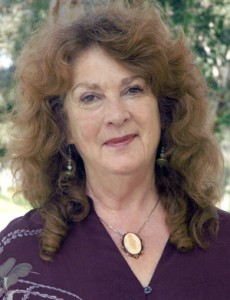Professor of Art Gilah Yelin Hirsch was selected as co-president elect of the International Society for the Study of Subtle Energies and Energy Medicine (ISSSEEM) and will preside over the organization’s annual conference in 2012. A transcription of Hirsch’s presentation on “Biotheology, Imagery, and Healing” from ISSSEEM’s annual conference last June, which included a most comprehensive survey of reproductions of paintings spanning her entire career, was published in the recent issue of the organization’s journal, Subtle Energies and Energy Medicine.

Hirsch, who shares the office of co-president elect with energy medicine expert Dr. Karl Maret, says that she hopes to further ISSSEEM’s mission of expanding the knowledge of integrative healing and the subtle realms with a cross-cultural exchange, “by bringing innovators and leading thinkers in medicine, physics, psychiatry, and of course, the arts, from the East to the West and vice versa.”
“My hope is to [establish] a global clearinghouse where all pertinent research and papers would be documented,” Hirsch says. “Furthermore, I would like to expand the contemporary notion of science and scientists to include those investigating identical issues through different lenses in other disciplines.
“While Leonardo Da Vinci and Thomas Jefferson understood the significance and applied the insight of simultaneous interconnectedness derived from working in various disciplines, Western culture generally created increasingly limited perspectives,” she says. “During the 1960s when Eastern philosophy began to permeate the Western world, mysticism and science were revisited, e.g. quantum physics, superstring theory, [which] are both philosophies as well as science. Similarly, in medicine, that which causes illness and that which heals are being seen in a different, more holistic light. The best practices of many cultures–ancient to modern–can be documented, tested and adopted.”
On March 13, Hirsch will present “Confessions of a Multi-Hatted Artist: Summoning the Unified Field – An Investigation into the Relation Between Origin of Alphabet, Pattern in Nature and the Neurology of Perception” at The Salon on the Spiritually Creative Life in Pasadena, Calif.
Hirsch is completing a follow-up to her 1995 documentary, “Cosmography: The Writing of the Universe” with “Reading the Landscape,” a multicultural, multilingual, animated film for children that depicts the origins of the world’s alphabets. She says that there are five patterns that occur in nature and reflect the shapes of neurons and neural processes of perception and cognition.
“As a result of 30 years of investigation, it became clear to me that the art and architecture that has survived time in all cultures has been based on these five forms as well,” Hirsch notes. “The composition of each of my paintings as a whole and the forms that evolve within each work are based on these forms.
“The more an image reflects both inner and outer, micro to macro, hard-wired human structure, the more power it will hold over the viewer,” Hirsch says. “In western culture, pornography is the only arena in which it is widely known that images cause a psychophysiological change in the viewer. One must remember that all images cause psychophysiological and behavioral changes in the viewer. [All artists] must assume responsibility for the resulting affect.”
Last fall, Hirsch’s “Choice” was included in the exhibit, “Memory & Transformation,” at Hebrew Union College-Jewish Institute of Religion in Los Angeles. The solo exhibition of her “Vinosady Series” continues in its third year at Hebrew Union College as well. Last fall, she curated the exhibit “Winston Hewitt: A Retrospective Exhibition of his Paintings and Prints,” which was featured in the University Art Gallery at CSU Dominguez Hills.
This spring, Hirsch’s upcoming exhibitions include a solo exhibition at The Vincent Gallery in Moscow and the annual invitational “Incognito” benefit at the Santa Monica Museum of Art. Several of her paintings will be featured in the “Visionary Art” exhibition at Ebenezer HerChurch in San Francisco this summer, in which artists who were exhibited in the first “Visionary Art” exhibition held in that venue in 1974 will show recent works.
Hirsch was recently included in “LA Rising: SoCal Artists Before 1980,” by Lyn Kienholz, arts advocate and founder of the California/International Arts Foundation. This groundbreaking encyclopedia of artists who established Los Angeles as a world art center was published and launched by The Getty Foundation last December. In addition, Hirsch has written a new book on her mother, Shulamis Yelin, the Canadian writer, educator, and poet. “Shulamis: A Storied Life – From the Demonic to the Divine,” will be released in October by Véhicule Press of Montreal.
Her most recent presentation includes “Artist as Shaman – Conjuring Healing: Imagery, Bio-theology, Health and Right Action,” at the conference of the Institute of Ethnology & Anthropology at the Russian Academy of Sciences (RAS) in the Republic of Buryatia last July. It will be published in the Russian Academy of Sciences Journal of Ethnology and Anthropology in both Russian and English. Other recent journal publications include “Biotheology, Imagery, and Healing: An Exploration into the Relationship Between Calcium and Bodhicitta, Health and Right Action” in Shaman: Journal of the International Society for Shamanistic Research and the article, “Eskimos Have No Word or Concept for ‘Future:’ Cultural Suicide in Nunavut,” which was originally published by the Russian Academy of Sciences, Center for Medical Anthropology in 2009 and reprinted in the Journal of the Institute of Ethnology and Anthropology last year. In addition, Hirsch’s painting “Shy Lily,” from her “Dorland Pond Series” was featured as cover art for a recent issue of Bridges Magazine, published by ISSSEEM, and her “Aurora Impassionata” is currently featured in Poetica Magazine.
For information on the Art and Design Department at CSU Dominguez Hills, click here.